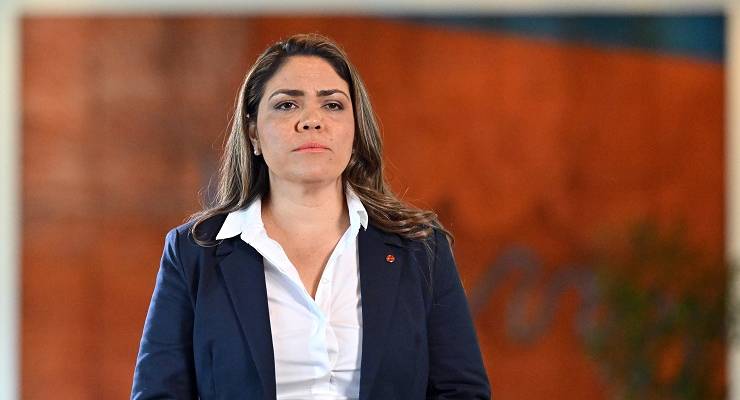
When Senator Jacinta Price poured scorn on the Indigenous Voice in her first speech to the 47th Parliament a few weeks ago, few First Nations peoples were surprised. Price was elected to represent the Northern Territory from the Country Liberal Party. Her mother, Bess Price, was a favourite of John Howard’s, and gave vocal support to the NT Intervention.
But for some non-Indigenous Australians looking for guidance on how to think and feel about enshrining an Indigenous Voice to Parliament in the Australian constitution, Price’s remarks caused confusion and concern.
Hadn’t there been a long process that had achieved consensus among the Aboriginal and Torres Strait Islander communities about what was needed to advance their causes? And if there was no agreement that the Voice would help, how should the rest of us vote in the 2023 referendum?
The answer to the first question is yes, there was an extended, First Nations-driven process that took place over years, culminating in a collectively written plea from Indigenous peoples — the Uluru Statement from the Heart — part of which requests a constitutionally enshrined Indigenous Voice to the federal Parliament.
Following this, further work was done, such as the 272-page report by Professor Marcia Langton and Professor Tom Calma on the results of the co-design process that fleshed out what a Voice to Parliament would look like (“a cohesive and integrated system comprised of local and regional Voices and a national Voice with connections to existing Aboriginal and Torres Strait Islander bodies”) and how it should be implemented (in continued partnership with local and regional Voices).
But while the Uluru statement claims to represent the largest consensus of First Nations peoples, the Langton-Calma report is more modest. It says that while its final proposals “represent either the unanimous or clear majority view of the co-design groups”, it doesn’t represent everyone.
Which should be obvious. We wouldn’t expect white people to agree on even low-stakes quandaries like the best colour to paint a house, whether Velcro or shoelaces on sneakers are better, or whether the week starts on Sunday or Monday. Why we would think a consensus view would or should emerge among the land’s 798,400 First Nations peoples about a high-stakes question about how to build a better future for themselves, their kids, and their communities?
Especially when the answer to that question is liberally seasoned with the disappointment, rage and betrayal of the four previous attempts to fashion a version of the same representative solution. And when we know how much internecine dissent was papered over by Reconciliation Australia seven years ago when the question up for debate was whether Aboriginal and Torres Strait Islander peoples wanted to be recognised within the Australian constitution — and if so, what form that recognition would take.
This is not to say that I think Price’s critique of the Voice is intelligible or even made in good faith (but as it happens, I don’t). My point is that those of us wanting a clear signal from First Nations peoples on how we should think about the Voice and vote next year need to stop such silliness.
Because in the same way that there is no singular point of view of “white people” or “women”, there’s no unified “Indigenous” one either. If we want to know how to vote, we’ll need to do what we do on every other issue: take the advice of someone we trust, or find some reputable sites, do some reading and make up our own bloody minds.
Is there a need for clarification or expansion in the Voice? Let us know your thoughts by writing to letters@crikey.com.au. Please include your full name to be considered for publication. We reserve the right to edit for length and clarity.








Well said! Price is no more a spokesperson for indigenous people than Pauline Hanson is for white Australians.
But both of them represent the views of a subset of each group. That’s kind of the point
Agreed. So pleased to read this article which provides more information about what the voice actually is meant to be andsituation than is generally available in the media. I’m tired of hearing people say ‘there’s plenty of detail on the voice out there’ with apparently no recognition that most people are not aware of it and are unlikely to research it before a vote is held. The ‘no’ vote may win purely due to ignorance and apathy, unless the general issues discussed here are well-known to all people who vote, rather than just those who have an interest in the issues.
People are busy and preoccupied, so only pay attention to those things that they think will affect them, so broad media coverage is necessary to prevent misinformation and ignorance destroying the chance for aboriginal perspectives to be considered in decision-making.
The idea that any “minority group” has to agree on every dot and comma is an excuse for not listening at all and ignoring concerns. The same thrust of this article is used against many others e.g. disabilities, LGBTIQA+.
Sadly some people from communities internalise the nonsense and fall for it.
So very glad to see the nonsense being called out for what it is – thank you for the article.
Thanks for the thanks Sally!
Thanks Leslie, I think there is a missed additional 8ssue here is that non-indigenous people are not “white” – from non-anglo Europeans, and those from Asia, Africa and elsewhere.
There is an underlying tone that the Voice/Treaty debate is invader v invaded, an original sin that I think is unfairly applied to millions who came to Australia with literally no alternative. I should emphasize that this is a very different situation to New Zealand, whose treaty was agreed long before multicultural migration and refugees.
Nobody alive today actually invaded Australia, but we all benefit from living here. Drawing a distinction between those of Anglo heritage and non-Anglo heritage is silly. And what about those of convict ancestry?
My honest answer is that I don’t know, but it is a worthwhile discussion to be had.
We make these distinctions in so many other areas of our politics, such as the implied “White v Vietnamese” election in Fowler, the justly call for nuance regarding so called “African gangs”, and yet in this reform we seem to be sliding towards an overly simplistic “Black v White” way of thinking about fundamental democratic institutions.
Frankly, some of us come from stock who fled countries where race defined political representation. And I think there is scepticism for even the most altruistic measure.
This has nothing to do with migration regardless of the white/black indigenous stuff.
If this “…has nothing to do with migration…” is that because migrants, of whatever hue, are another ‘protected-from-scrutiny’ group?
As we all know everyone, except whities, lives in harmony singing kumbaya without any sign of intolerance.
Well of course they don’t.
We who are alive now did not invade Australia but we are alive now and there are still too many deaths in custody of our Aboriginal population, far too many incarcerated including children, and far too many dying and suffering ill health at a greater degree than the rest of the population. We are here now and it is up to us to ensure that all means possible are used to change this scenario.
Almost fully agree, I think a more immediate, and faster fix, is … Money!
Properly funded services, economics support for indigenous communities, supporting and buying from indigenous businesses, funded by a proper progressive tax system – supporting economic empowerment and self determination rather than just those institutionally connected.
Sometimes I think the Voice debate is just a cover for our hip pockets.
Yes, under capitalism we all equat to a dollar value. Democracy was meant to uphold the scales of justice to balance inequality and power.
Literally, ideologically and financially the scales are not balanced.
Odd that the solution is always ‘throw more money’ – as if the billion$ wasted each year are insufficient.
Rather spend some on a 1st nations referendum than what the last gvt spent it on.
If the YES vote wins then what is the Voice going to cost ?
We spend billions every year and the result is still the same. Put a figure on it. How much is enough?
Because I’m sick of paying already.
Oh jeepers creepers, been there done that, move on, this has nothing to do with anyone else but Australian indigenous culture.
I think with this vote there are two questions we need to answer – an easy question and a hard question.
The easy question is the moral one: should we enshrine moral worth to the indigenous populations that were here long before 1788?
The hard question is: what function would such a role serve legislatively?
I call them easy and hard because the moral one is an intuitive one. Either we see the purpose of recognising indigenous cultures or we do not. There’s not a lot of debate to be had one way or the other. The hard question is where I think the no campaign is going to focus because it could be quite easy to cast this as either meaningless symbolism or a complaint about enshrining inequality into our legal system. Figuring that out is where we need to look at how other countries have done it and what the implications are there.
This is a great way of framing it Kel, and I worry that the debate is framing the second question as inseparable from the first. My answer to the first is a wholehearted yes, but the second is, as you say, very hard. I worry that it will be impossible to ask it without being dismissed as racist but if we take our Constitution and system of government seriously, we absolutely have to ask it.
In the same way that it was Deves job to dog whistle the red necks that the LNP are still, and will always be ok , with persecuting gays and trans and all other deviants, Jacinta Price is there to dog whistle that the LNP will always work to keep the indigenous in their box.